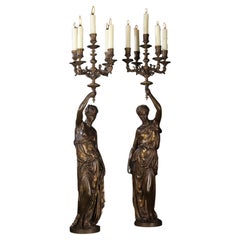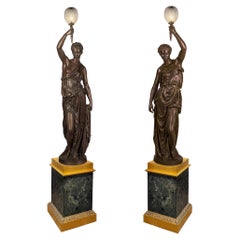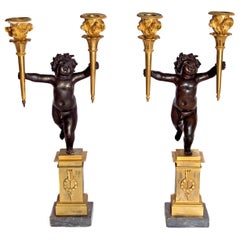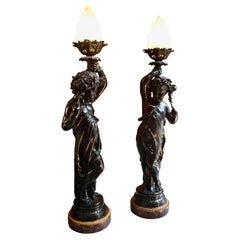Paul Dubois Floor Lamps
to
1
1
2
Height
to
Width
to
1
1
2
2
2
2
2
2
2
2
6
242
182
172
138
Creator: Paul Dubois
Pair of Gilt and Patinated Bronze Candelabra by Ferdinand Barbedienne
By Paul Dubois, Ferdinand Barbedienne
Located in Brighton, West Sussex
A Pair of Gilt and Patinated Bronze Figural Five-Light Candelabra Cast by Barbedienne after the Models by Alexandre Falguière and Paul Dubois.
Signed ‘FALGUIERE’ and ‘P. DUBOIS’ ...
Category
19th Century French Antique Paul Dubois Floor Lamps
Materials
Bronze
Important Pair of Monumental Parcel-Gilt and Patinated Bronze Figural Torchère
By Jean Alexandre Joseph Falguière 1, Ferdinand Barbedienne, Paul Dubois
Located in New York, NY
Mounted as lamps and cast by Ferdinand Barbedienne after models by Alexandre Falguiere and Paul Dubois. Both statues are signed on the bases.
These fine torchères are reductions ...
Category
Late 19th Century French Renaissance Antique Paul Dubois Floor Lamps
Materials
Bronze
Related Items
Pair of French Charles X Patinated Bronze and Gilt Figurative Candelabras
Located in Dallas, TX
A fine pair of figurative candelabras in the form of a patinated bronze cherub running with a gilt torchiere in each hand. The cherubs stand on a...
Category
Early 18th Century French Charles X Antique Paul Dubois Floor Lamps
Materials
Marble, Bronze
$2,600 / set
H 16.5 in W 7 in D 3.25 in
Matching Pair of Figural Patinated Bronze Flame Torcheres after Clodion
By Claude Michel Clodion
Located in Vancouver, British Columbia
A beautifully cast matching pair of patinated bronze figural torcheres in the manner of Clodion modeled as classically draped young girls with garlands of flowers in their hair and h...
Category
Late 19th Century French Napoleon III Antique Paul Dubois Floor Lamps
Materials
Bronze
Pair of Regency Gilt and Patinated Bronze Atlas Figural Candelabra
By Messenger & Phipson
Located in Essex, MA
Pair of Regency or William IV figural candelabra in form of Atlas and a globe. Six arms issuing from top. Patinated bronze, gilded bronze and bronze. A truly rare from. Attributed to...
Category
Early 19th Century English Neoclassical Antique Paul Dubois Floor Lamps
Materials
Bronze
$16,500 / set
H 27 in W 13 in D 12 in
Pair 19th Century Japanese Porcelain and Gilt Bronze Mounted Torchere Floor Lamp
By Imari Porcelain
Located in Los Angeles, CA
A fine pair of 19th century Japanese porcelain and French gilt bronze mounted thirteen-light celadon torchiere, floor lamp candelabra. Wired for ...
Category
19th Century Japanese Rococo Antique Paul Dubois Floor Lamps
Materials
Bronze
$29,850 / set
H 64.25 in Dm 25 in
Pair of Continental Green and Parcel Gilt Decorated Floor Lamps
Located in Germantown, MD
A Pair of Continental Green and Parcel Gilt Decorated Floor Lamps
Measures 9" in width, 9" in depth and 57" in height.
Category
Late 20th Century American Other Paul Dubois Floor Lamps
Materials
Metal
Rare and Palatial Pair of Gilt Bronze and Malachite Seven Light Torcheres
Located in Long Island City, NY
A Rare and Palatial Pair of Mid 20th Century Gilt Bronze and Malachite Six Light Torcheres
The body of baluster form above a gilt bronze mounted circular and square base, the neck mounted with flowers and foliage leading up to seven tiered bronze acanthus arms.
Malachite is a semi-precious stone and also a valuable copper ore, hydrous copper carbonate. It is a beautiful green earth stone with irregular black banding. It is easily recognized by its color, green streak, and silky or velvety luster. It was used to make beautiful jewelry and to adorn only the finest pieces of furniture. In the 18th and 19th centuries malachite was popular with Russian Czars...
Category
Mid-20th Century French Belle Époque Paul Dubois Floor Lamps
Materials
Malachite, Bronze, Ormolu
$275,000 / set
H 96 in W 20 in D 20 in
Pair 19th Century Japanese Imari Porcelain & Gilt-Bronze Torchere Candelabra
By Imari Porcelain
Located in Los Angeles, CA
A fine Pair of 19th century Japanese Imari Porcelain and French Gilt-Bronze Mounted Thirteen-Light Celadon Torchere Candelabra. The bottle-shaped Japonisme vases with a Royal red background, decorated with parcel-gilt and black soaring eagles in the hunt within a forestall scene. Each Vase fitted and surmounted with a French 19th century Louis XV Style 13-Light scrolled candelabrum and all raised on a circular pierced gilt-bronze plinth. circa: 1880.
Imari Porcelain (????) is the name for Japanese porcelain wares made in the town of Arita, in the former Hizen Province, northwestern Kyushu. They were exported to Europe extensively from the port of Imari, Saga, between the second half of the 17th century and the first half of the 18th century. The Japanese as well as Europeans called them Imari. In Japanese, these porcelains are also known as Arita-yaki (???). Imari or Arita porcelain has been continously produced up through the present day.
Characteristics
Though there are many types of Imari, Westerners' conception of Imari in the popular sense is associated only with a type of Imari produced and exported in large quantity in mid-17th century. This type is called Kinrande. Kinrande Imari is colored porcelain with cobalt blue underglaze and red and gold overglaze. The color combination was not seen in China at that time. Traditional Ming dynasty color porcelain used dominantly red and green, probably due to scarcity of gold in China, whereas gold was abundant in Japan in those days. The subject matter of Imari is diverse, ranging from foliage and flowers to people, scenery and abstractions. Some Imari design structures such as kraak style were adopted from China, but most designs were uniquely Japanese owing to the rich Japanese tradition of paintings and costume design. The porcelain has a gritty texture on the bases, where it is not covered by glaze. There is also blue and white Imari. Kakiemon style Imari is another type of Imari, but it tends to be categorized separately in Europe.
History
"Imari" was simply the trans-shipment port for Arita wares. It was the kilns at Arita which formed the heart of the Japanese porcelain industry.
Arita's kilns were set up in the 17th century, when kaolin was discovered in 1616 by the immigrant Korean potter, Yi Sam-pyeong (1579–1655). (He may also be known by the name, "Kanage Sambei".) Yi Sam-Pyeong, along with his extended family of 180 persons, left Korea on the offer of a privileged position in Japan. This decision was made after the occurrence of certain Japanese invasions of Korea. After Yi Sam-Pyeong's discovery, his kilns began to produce revised Korean-style blue and white porcelains, known as "Shoki-Imari".
In the mid-17th century there were also a lot of Chinese refugees in Northern Kyushu due to the turmoil on Chinese continent, and it is said one of them brought coloring technique to Arita. Thus Shoki-Imari developed into Ko-KutaniImari. Ko-Kutani was produced around 1650 for both export and domestic market. Blue and white porcelain continued to be produced and they are called Ai-Kutani. Ko-Kutani Imari for the export market usually adopted Chinese design structure such as kraak style, whereas Ai-Kutani for the domestic market were highly unique in design and are accordingly valued very much among collectors.
Ko-Kutani style evolved into Kakiemon style Imari, which was produced for about 50 years around 1700. Imari achieved its technical and aesthetic peak in Kakiemon style, and it dominated European market. Blue and white Kakiemon is called Ai-Kakiemon. Kakiemon style transformed into Kinrande in the 18th century. Kinrande used blue underglaze and red and gold overglaze, and later some other colors.
Imari began to be exported to Europe because the Chinese kilns at Ching-te-Chen were damaged in the political chaos and the new Qing dynasty government stopped trade in 1656–1684. Exports to Europe were made through the Dutch East India Company, but the designation "Imari Porcelain" in Europe connotes Arita wares of mostly Kinrande Imari.
Export of Imari to Europe stopped in mid-18th century when China began export to Europe again, since Imari was not able to compete against China due to high labor cost. By that time, however, both Imari and Kakiemon style were already so popular among Europeans, Chinese export porcelain copied both Imari and Kakiemon style, which is called Chinese Imari. At the same time, European kilns, such as Meisen also tried to copy Imari and Kakiemon.
Export of Imari surged again in late 19th century (Meiji era) when Japonism flourished in Europe. Thus in western world today, two kinds of Imari can...
Category
19th Century Japanese Japonisme Antique Paul Dubois Floor Lamps
Materials
Bronze, Ormolu
$24,850 Sale Price / set
49% Off
H 72.25 in Dm 24.25 in
Monumental Pair of Italian 18th Century torchère in Painted and Giltwood
Located in Round Top, TX
A truly exquisite pair of 18th century Northern Italian torchère in painted and giltwood. The shades are pierced metal and polychromed. They are lined in a white silk.
Category
Late 18th Century Antique Paul Dubois Floor Lamps
Materials
Wood
$15,000 / set
H 85.5 in W 20 in D 20 in
Pair French 19th-20th Century Neoclassical Style Iron and Parcel-Gilt Torcheres
Located in Los Angeles, CA
A Palatial Pair of French 19th/20th Century Neoclassical Revival Style Ebonized Cast-Iron and Parcel-Gilt Torcheres (torchières - Lamp Posts). The park-like torcheres surmounted with...
Category
Early 1900s French Neoclassical Revival Antique Paul Dubois Floor Lamps
Materials
Iron, Zinc
$19,850 Sale Price / set
30% Off
H 102 in Dm 29 in
Monumental Gilt and Patinated Bronze Candelabra by Beurdeley
By Maison Beurdeley
Located in London, GB
Monumental gilt and patinated bronze candelabra by Beurdeley
French, late 19th century
Measures: Height 273cm, width 90cm, depth...
Category
Late 19th Century French Baroque Antique Paul Dubois Floor Lamps
Materials
Marble, Ormolu, Bronze
$478,363 / set
H 107.49 in W 35.44 in D 35.44 in
Monumental Pair of Italian Empire Gilt Bronze Candleholders or Floor Lamps, 1800
Located in Rome, IT
Impressive pair of Italian Empire finely chiseled ormolu Flambeaux, on triform base, each with 25 scrolled gilt-bronze candle arms. Attributed to Luigi Manfredini the famous bronze a...
Category
Early 1800s Italian Empire Antique Paul Dubois Floor Lamps
Materials
Bronze
$113,821 Sale Price
20% Off
H 72.84 in Dm 21.66 in
Two Orientalist Patinated and Gilt Bronze Figural Torchères by Barbedienne
By Émile Guillemin, Ferdinand Barbedienne
Located in London, GB
Émile Coriolan Hippolyte Guillemin, the famous French sculptor, designed these exquisite bronze figural torchères in circa 1880. Guillemin was an accomplished artist, who regularly exhibited at the Salon in Paris from the 1870s-1890s. Indeed, Guillemin showcased the original models for these candelabra at the Salon of 1872 to great acclaim. Guillemin’s designs were realised in bronze by the famous metalworker and foundry owner, Ferdinand Barbedienne. The Barbedienne factory was of the leading producers of artistic bronzes in the 19th century. The firm enjoyed great success, winning multiple awards at the major International Exhibitions of the period. The torchères are signed, ‘Ele Guillemin’ and stamped, ‘F. Barbedienne. Fondeur’, with an ‘A. Collas’ reduction stamp.
Described in Barbedienne’s catalogue of 1886 as ‘Deux Femmes, Indienne et Persane’, these torchères take the form of an Indian and Persian woman. Each figure holds a five-light candelabrum above her head, composed of scrolled branches, wide gadrooned drip-pans, and foliate urn-shaped capitals. The Persian woman wears loose trousers, with a small top and short jacket. The Indian woman is dressed in a knotted skirt...
Category
Late 19th Century French Neoclassical Antique Paul Dubois Floor Lamps
Materials
Bronze
$47,836 / set
H 37.8 in W 10.24 in D 10.24 in
Paul Dubois floor lamps for sale on 1stDibs.
Paul Dubois floor lamps are available for sale on 1stDibs. These distinctive items are frequently made of metal and are designed with extraordinary care. There are many options to choose from in our collection of Paul Dubois floor lamps, although gold editions of this piece are particularly popular. If you’re looking for additional options, many customers also consider floor lamps by and Ferdinand Barbedienne. Prices for Paul Dubois floor lamps can differ depending upon size, time period and other attributes — on 1stDibs, these items begin at $80,522 and can go as high as $95,000, while a piece like these, on average, fetch $87,761.



